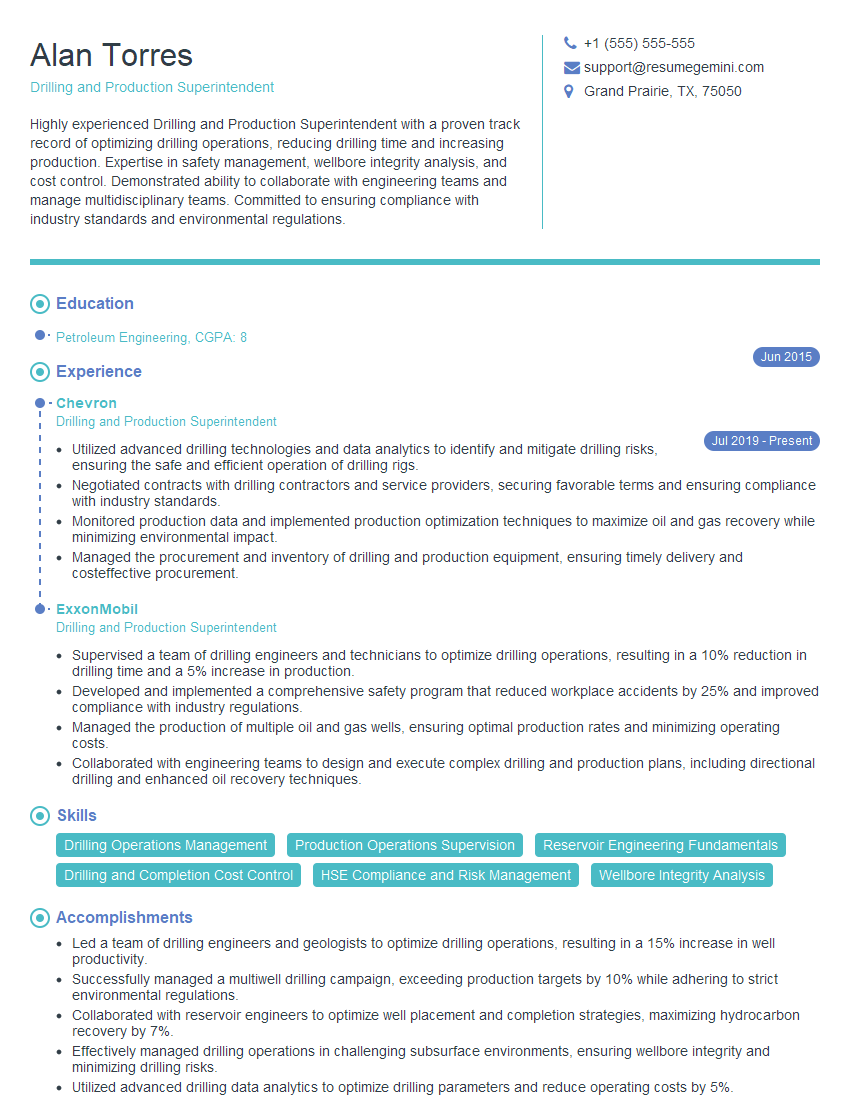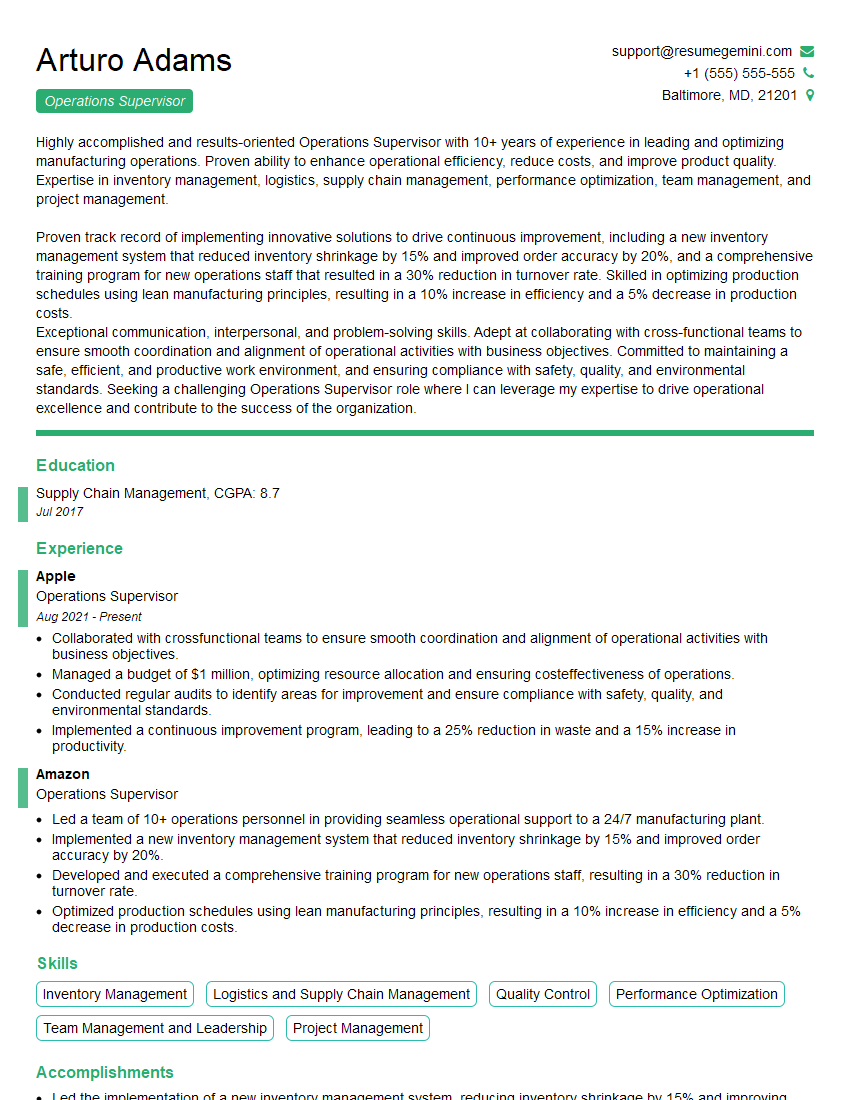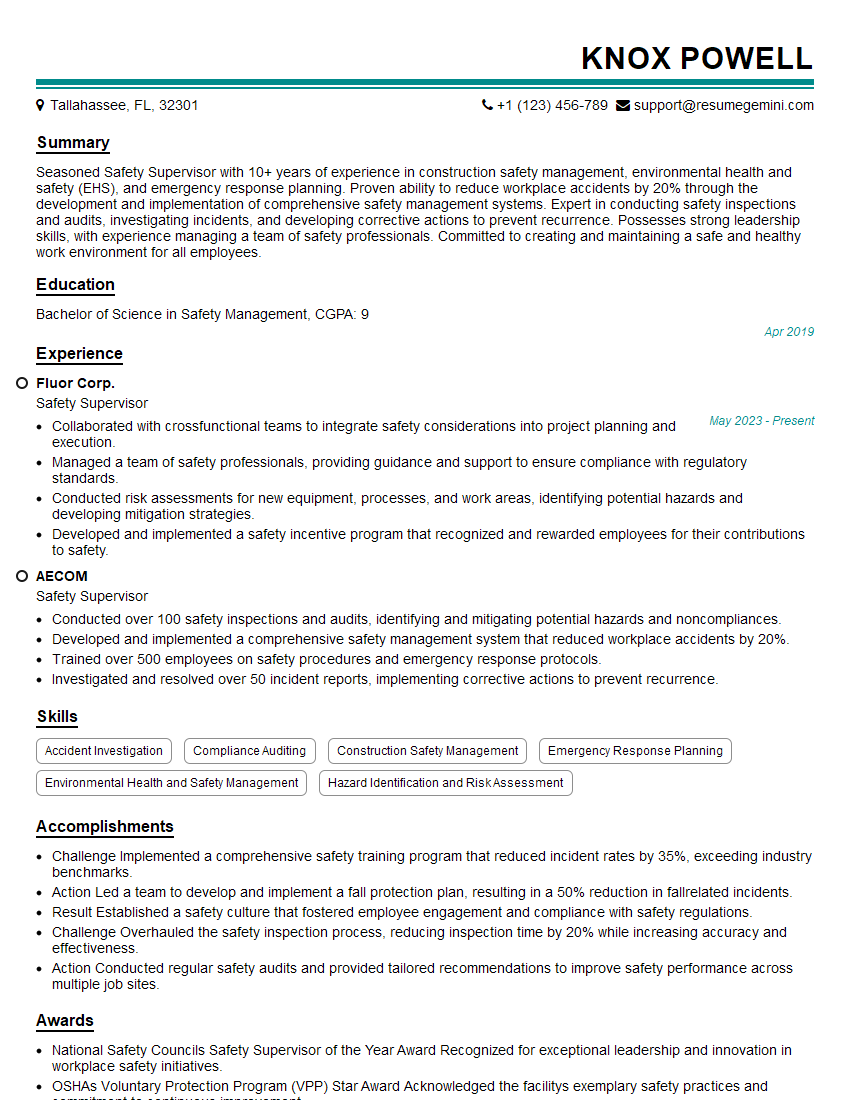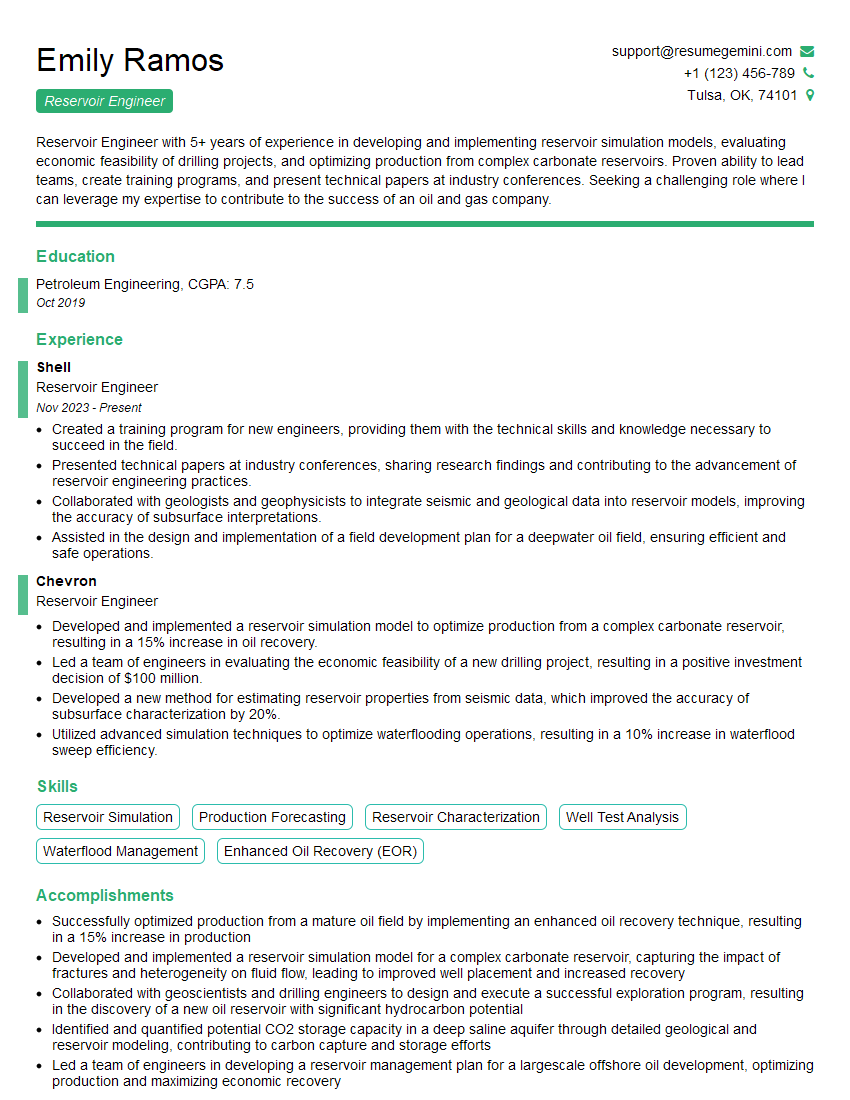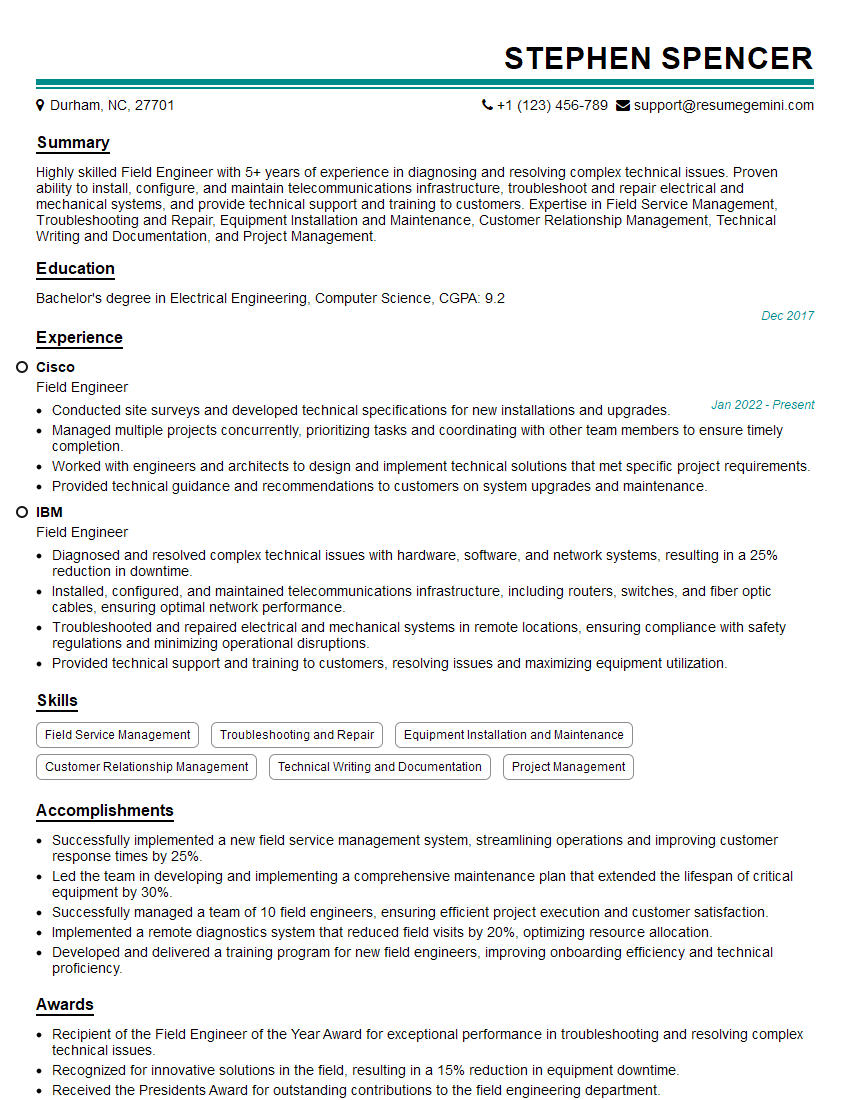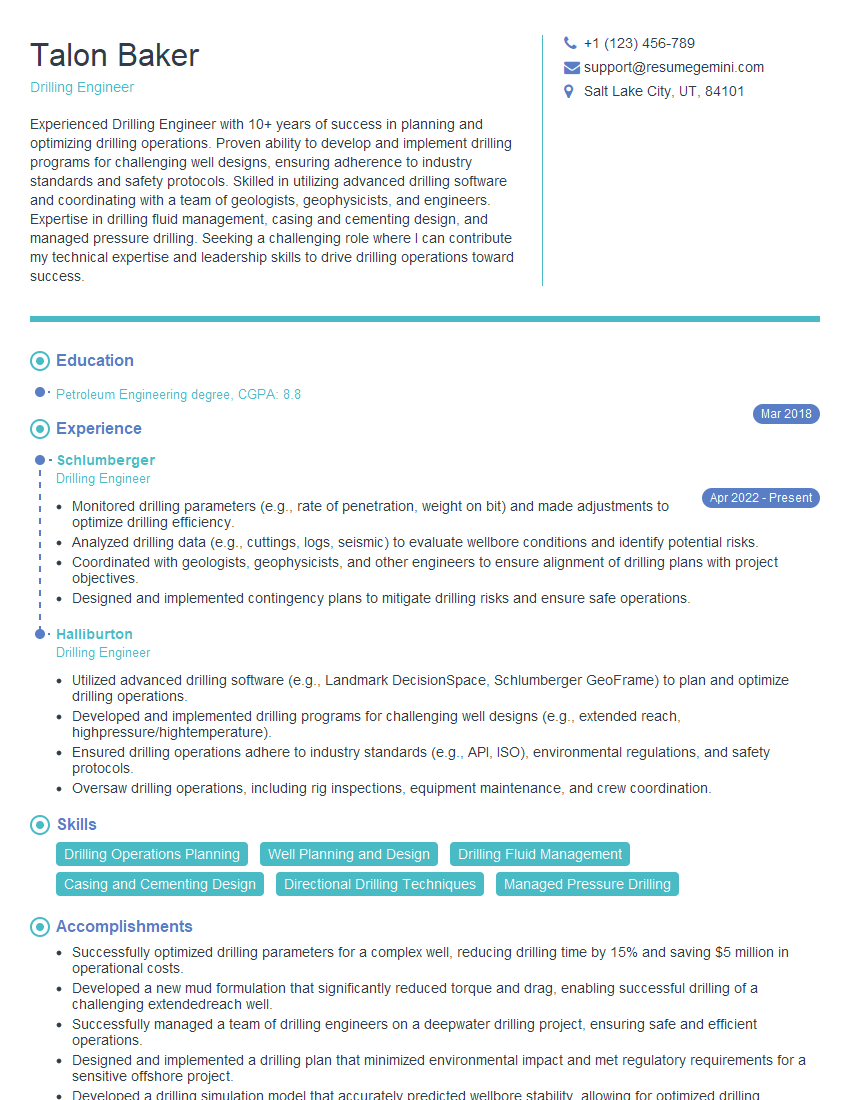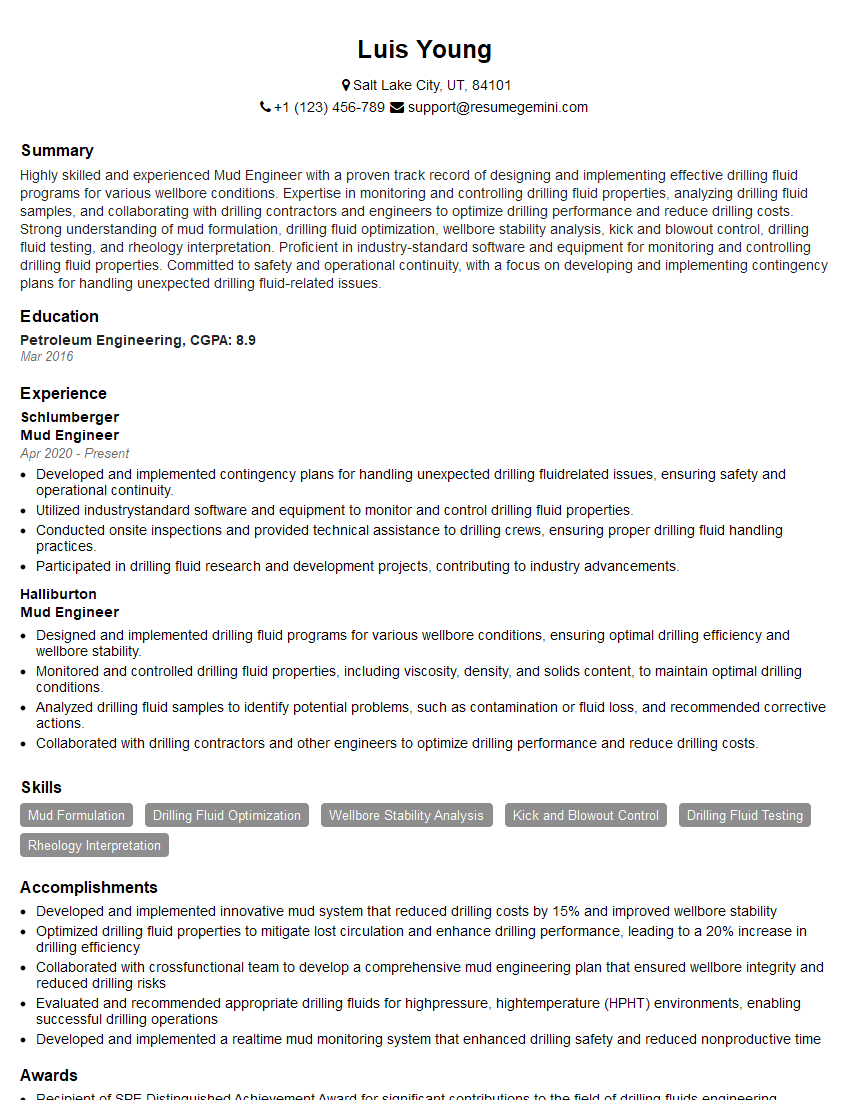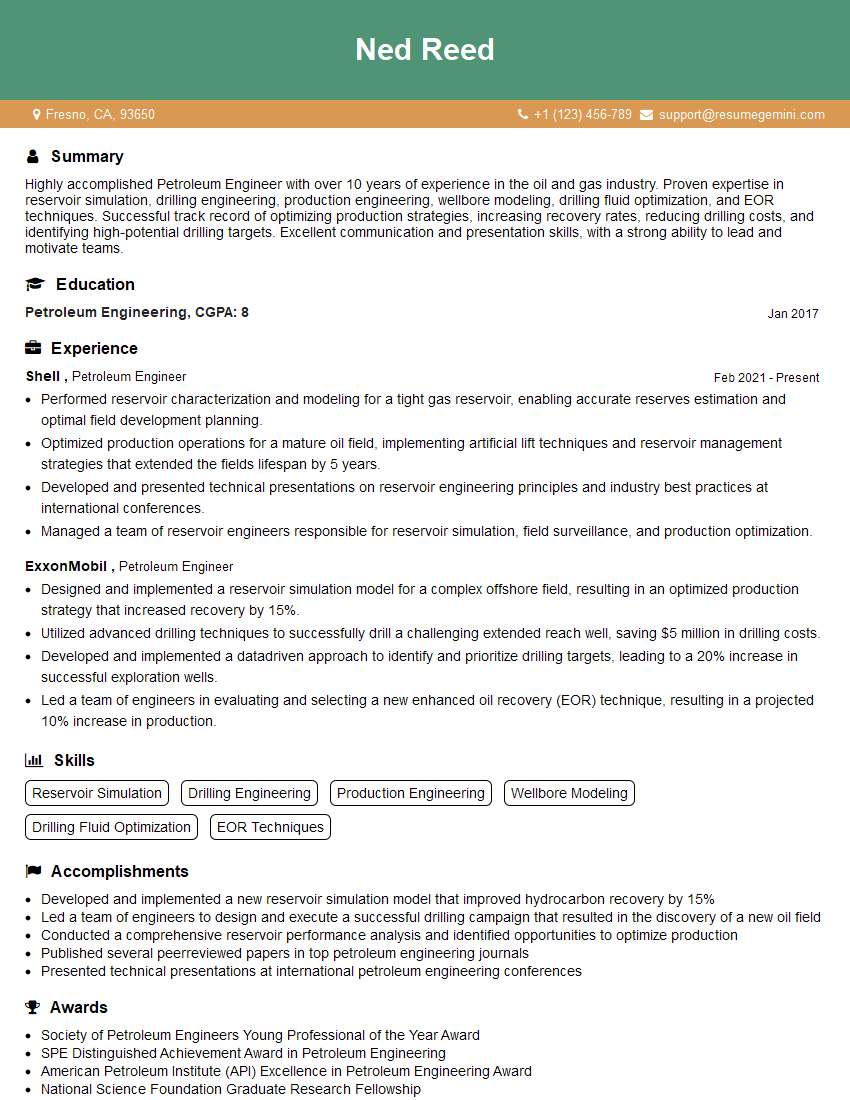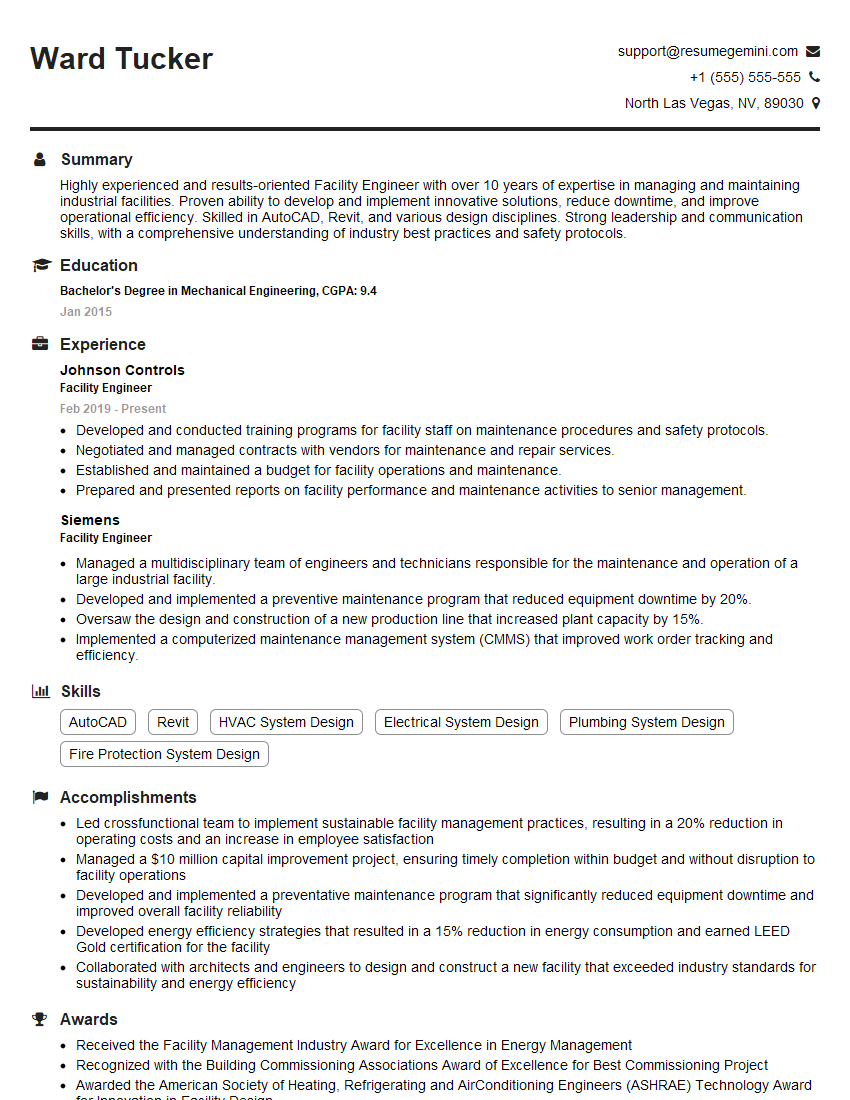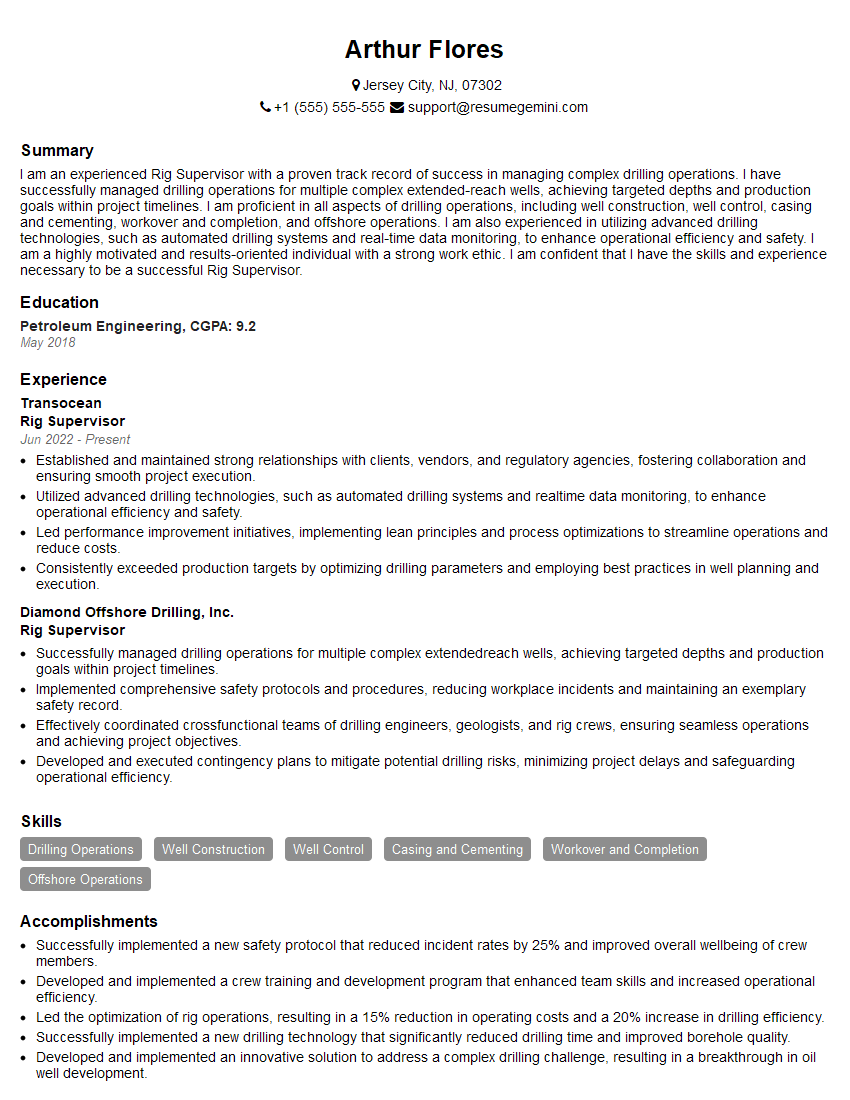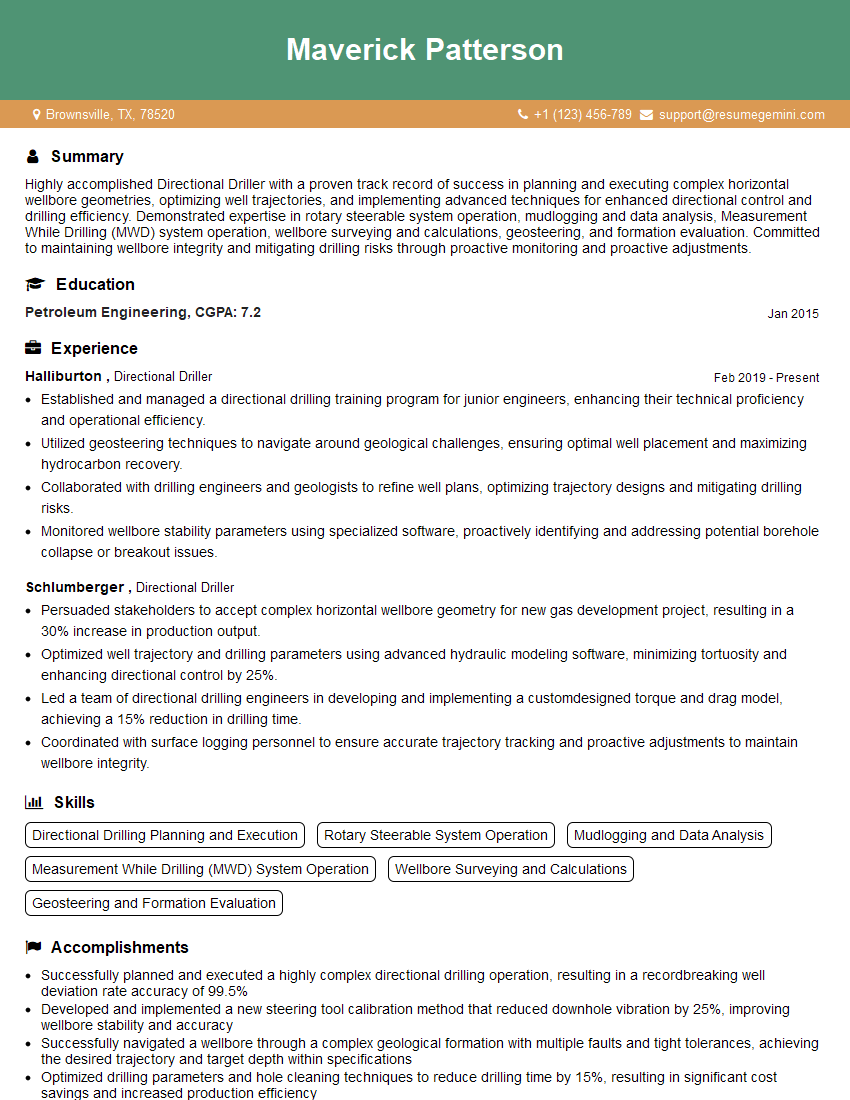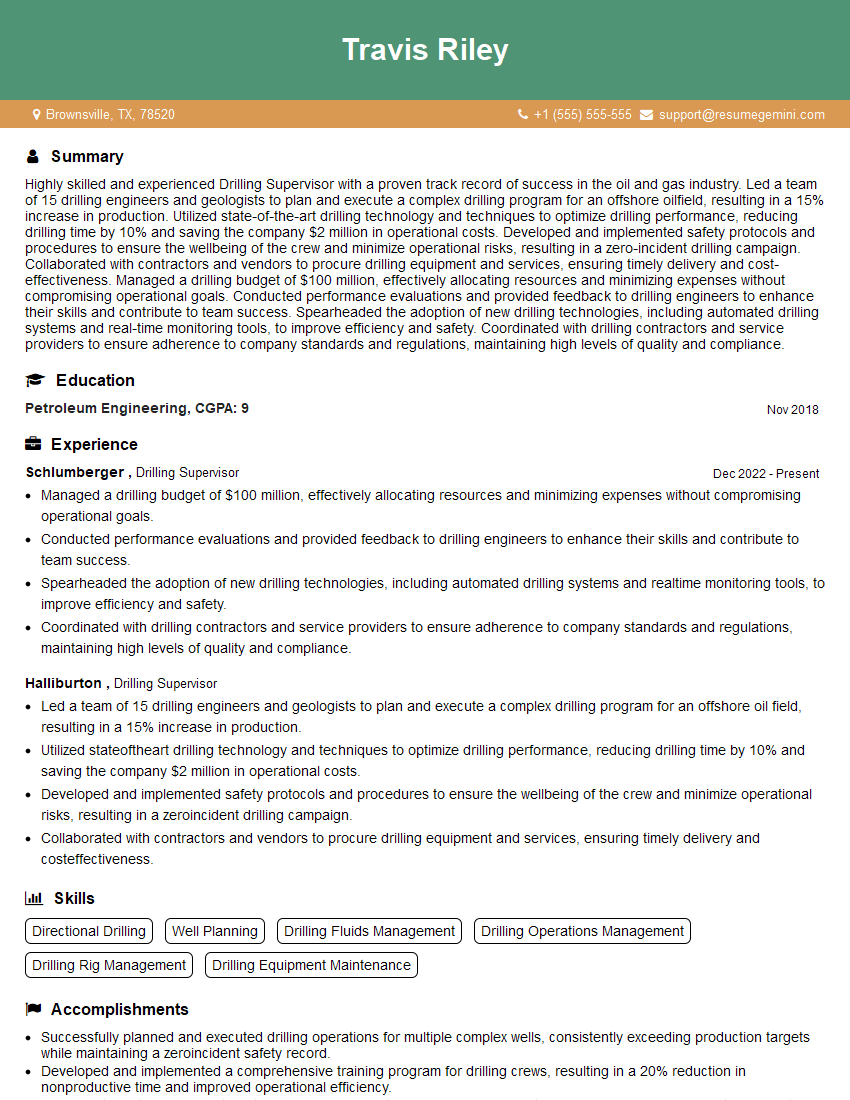Preparation is the key to success in any interview. In this post, we’ll explore crucial Drilling and Production Supervision interview questions and equip you with strategies to craft impactful answers. Whether you’re a beginner or a pro, these tips will elevate your preparation.
Questions Asked in Drilling and Production Supervision Interview
Q 1. Describe your experience with different drilling methods (e.g., rotary, directional, horizontal).
My experience encompasses a wide range of drilling methods, primarily focusing on rotary, directional, and horizontal drilling. Rotary drilling, the most common method, uses a rotating drill bit to bore through the earth. I’ve overseen numerous projects employing this technique, optimizing bit selection, weight on bit, and rotational speed to achieve optimal penetration rates and minimize drilling time. Directional drilling allows for the precise placement of the wellbore at various angles, essential for reaching targets in complex geological formations or accessing multiple reservoir zones from a single surface location. A project I led involved successfully navigating a highly deviated wellbore through a challenging fault zone using advanced directional drilling techniques and real-time monitoring. Finally, horizontal drilling extends the wellbore horizontally through the reservoir, significantly increasing contact with the producing formation and improving hydrocarbon recovery. I’ve managed several horizontal well projects, focusing on efficient well placement and completion strategies to maximize productivity.
For example, in one project, we successfully used a combination of rotary drilling for the initial vertical section followed by directional drilling to reach the target reservoir zone. Then we switched to horizontal drilling to create a long horizontal section within the reservoir. This strategic approach minimized costs and significantly improved oil recovery rates.
Q 2. Explain your understanding of well control procedures and emergency response protocols.
Well control and emergency response are paramount to safe and efficient drilling operations. My understanding encompasses the entire spectrum of well control procedures, from preventative measures like maintaining accurate mud weights and pressure monitoring to responding to well kicks and potential blowouts. I’m proficient in using various well control equipment, including blowout preventers (BOPs), and I’ve led numerous well control drills and emergency response training exercises to ensure personnel are fully prepared. Our protocols adhere to industry best practices and regulatory guidelines. They involve a well-defined hierarchy of authority, clear communication channels, and pre-planned response strategies based on different scenarios. We document every step of the process, including pre-job hazard analysis and detailed incident reports.
For instance, during one operation, we experienced a minor well kick. Following established procedures, we immediately initiated a shut-in procedure, isolating the well using the BOPs, and carefully circulated the well to remove the influx of formation fluids. A thorough post-incident analysis identified the root cause—a minor discrepancy in the mud weight—allowing for corrective actions to prevent recurrence.
Q 3. How do you monitor and optimize production rates to maximize well performance?
Monitoring and optimizing production rates is critical for maximizing well performance and overall field profitability. This involves continuous monitoring of key parameters such as pressure, flow rate, water cut, and gas-oil ratio. We use advanced sensors and data acquisition systems to gather real-time data, which is then analyzed using specialized software. This data informs decisions on artificial lift optimization, flow control adjustments, and any necessary remedial work.
For instance, a well exhibiting declining production rates might be analyzed to identify the cause – whether it’s reservoir depletion, formation damage, or equipment malfunction. Then we can implement strategies such as installing an artificial lift system (e.g., ESP or gas lift) to improve flow, conducting a stimulation treatment to improve reservoir permeability, or repairing or replacing faulty equipment. We regularly review production data to identify any anomalies or trends that may indicate a potential problem and take proactive steps to mitigate these issues before they lead to significant production losses. Regular maintenance and preventative measures are key aspects of optimization.
Q 4. What are the key factors influencing reservoir pressure and production decline?
Reservoir pressure and production decline are influenced by a multitude of interacting factors. Reservoir pressure is determined by the volume and compressibility of the fluids within the reservoir, the rock properties, and the presence of any natural or induced fractures. Production decline is a natural consequence of reservoir depletion, but its rate is also affected by factors such as reservoir heterogeneity, fluid properties (viscosity, density), and the efficiency of the production system. Other factors include the permeability of the rock, the amount of water coning, and the presence of gas coning.
For example, a decline in reservoir pressure can be observed due to the extraction of hydrocarbons, leading to a reduction in production rates. To manage this, we use reservoir simulation models to predict production decline and devise strategies for enhanced oil recovery (EOR) techniques such as water injection or gas injection to maintain reservoir pressure and prolong the productive life of the well.
Q 5. Describe your experience with managing drilling fluids and maintaining wellbore stability.
Managing drilling fluids (mud) and maintaining wellbore stability are crucial for safe and efficient drilling. The properties of the drilling mud—density, viscosity, and filtration—are carefully selected and monitored to maintain wellbore pressure, prevent formation collapse or fracturing, and carry cuttings to the surface. I have experience with various types of drilling fluids, including water-based, oil-based, and synthetic-based muds. The choice of mud type depends on the geological formation, environmental regulations, and operational requirements.
Wellbore instability can be caused by several factors such as weak formations, high pore pressures, or reactive shale. To mitigate these risks, we often implement various strategies including optimized mud weight control, the use of specialized mud additives to improve shale stability, and real-time wellbore stability monitoring tools to identify and react to early warnings of potential instability.
Q 6. How do you manage risks associated with drilling operations (e.g., H2S, blowouts)?
Managing risks associated with drilling operations, including H2S (hydrogen sulfide) and blowouts, requires a multi-layered approach. H2S is a highly toxic gas, and its presence necessitates stringent safety protocols. This includes pre-drilling hazard assessments, the use of specialized H2S detection equipment, mandatory training for personnel on H2S safety procedures, and the implementation of emergency response plans. Blowouts are catastrophic events that can result in significant environmental damage, property loss, and injuries. Preventing blowouts is crucial, and it involves rigorous well control procedures, regular equipment inspection, and ensuring personnel are well-trained in well control techniques.
For example, in an environment with known H2S potential, we implemented a comprehensive safety plan that included continuous monitoring of H2S levels, the use of specialized respirators, and mandatory evacuation procedures in case of H2S release. For blowout prevention, we conduct regular drills, meticulously maintain the BOP, and have established clear communication channels for handling any well control issue quickly and efficiently.
Q 7. What are your strategies for optimizing drilling efficiency and reducing non-productive time?
Optimizing drilling efficiency and reducing non-productive time (NPT) requires a proactive and data-driven approach. NPT represents significant cost overruns, so reducing it is a primary focus. We use various strategies to minimize NPT. This includes detailed pre-planning of the drilling program, including thorough geological assessment, selection of appropriate drilling parameters, and well-planned logistics. We continuously monitor drilling parameters, using advanced automation and real-time data analysis to identify potential problems and address them proactively. We also leverage advanced technologies such as rotary steerable systems (RSS) to improve drilling speed and directional accuracy. Efficient wellsite management, clear communication between the drilling crew and support personnel, and preventative maintenance programs are essential for minimizing downtime.
For example, we implemented a system to track NPT causes, enabling us to identify trends and address root causes of delays. This data-driven approach resulted in a significant reduction in NPT and improved overall drilling efficiency. Through continuous improvement efforts, we aimed for consistent optimization of the entire operation.
Q 8. Explain your experience with well completion and stimulation techniques.
Well completion and stimulation are crucial steps in maximizing hydrocarbon production. Completion involves equipping the wellbore to allow for efficient flow of oil and gas to the surface, while stimulation aims to increase reservoir permeability and improve flow rates. My experience spans various completion techniques, including:
- Conventional Completions: This involves setting casing and cementing to protect the wellbore and installing production tubing and packers to isolate zones and control fluid flow. I’ve overseen hundreds of these completions, optimizing the design for specific reservoir conditions. For instance, in a low-pressure reservoir, we’d use lighter weight casing and ensure effective zonal isolation to prevent fluid leaks.
- Multi-Stage Fracturing: I have extensive experience in designing and supervising multi-stage fracturing treatments, particularly in unconventional reservoirs like shale gas and tight oil formations. This includes selecting appropriate proppant types and volumes based on reservoir characteristics, monitoring treatment pressure and injection rates in real-time, and analyzing post-fracture production data to assess treatment effectiveness. For example, I once improved the production of a well by 30% by optimizing the proppant size distribution for a specific fracture geometry.
- Acidizing: I’ve managed numerous acid stimulation treatments, both matrix acidizing (for cleaning near-wellbore formation damage) and fracture acidizing (to enhance fracture conductivity). This includes careful selection of acid types and concentrations to avoid formation damage and ensure efficient dissolution of the formation rock. I always prioritize minimizing environmental impact through responsible acid management and waste disposal practices. One project I managed successfully minimized the acid volume required while achieving the desired stimulation, resulting in significant cost savings.
My experience includes working with various completion fluids, managing downhole equipment, and troubleshooting completion-related issues. I always strive to optimize completion designs to maximize production and minimize wellbore risks.
Q 9. How do you ensure compliance with HSE regulations in drilling and production operations?
HSE (Health, Safety, and Environment) compliance is paramount in drilling and production operations. My approach is proactive and multi-faceted, focusing on:
- Rigorous Pre-Job Planning: Before any operation, we conduct thorough risk assessments, develop detailed safety plans, and secure all necessary permits. This involves identifying potential hazards, implementing mitigation strategies, and providing comprehensive training to personnel. For example, a detailed emergency response plan is always in place to ensure swift and efficient response in case of an accident or spill.
- Stringent On-Site Monitoring: During operations, continuous monitoring is essential to ensure adherence to safety procedures. I enforce strict adherence to safe work practices, personal protective equipment (PPE) usage, and regular safety meetings. We utilize safety observation programs and near-miss reporting to identify potential risks before they escalate into incidents.
- Emergency Response Preparedness: We maintain up-to-date emergency response plans and conduct regular drills to ensure personnel are well-prepared to handle various scenarios, including well control incidents, fires, and spills. I personally ensure that all emergency equipment is regularly tested and maintained to guarantee readiness in case of an emergency.
- Environmental Protection: I prioritize environmental protection by ensuring strict adherence to environmental regulations related to waste disposal, emissions, and water management. Regular environmental monitoring and reporting are conducted to ensure compliance. For instance, I’ve implemented several projects to minimize wastewater generation and optimize disposal practices, leading to significant environmental benefit.
My commitment to HSE is reflected in my zero-incident record throughout my career. I firmly believe that a strong safety culture is not just a set of rules but a shared commitment to the well-being of everyone involved.
Q 10. Describe your experience with different types of well logging and interpretation.
Well logging provides invaluable data about subsurface formations. My experience encompasses various logging techniques, including:
- Open-Hole Logs: I’m proficient in interpreting Gamma Ray, Neutron Porosity, Density, Resistivity, and Sonic logs to determine lithology, porosity, permeability, and fluid saturation. This data is crucial in reservoir characterization and well completion design. For example, I used resistivity logs to identify hydrocarbon-bearing zones and determine their saturation.
- Cased-Hole Logs: I have experience with various cased-hole logging tools, such as cement bond logs, production logging tools, and nuclear magnetic resonance (NMR) logging. This allows for assessment of cement quality, identifying production zones, and characterizing fluid properties behind casing. I’ve used production logs to diagnose the causes of low production rates and optimize well performance.
- Special Logs: I have utilized specialized logging techniques such as formation micro-imager (FMI) logs and dipole shear sonic imaging (DSI) logs to obtain high-resolution images of the wellbore wall. This allows for detailed evaluation of fractures and other geological features. For example, I used FMI logs to identify and characterize natural fractures in a tight gas reservoir, which improved the design of the hydraulic fracturing treatment.
Data interpretation is a key aspect of my work. I utilize specialized software and my geological knowledge to integrate data from various logs to create a comprehensive reservoir model. This model is crucial in making informed decisions regarding well completion, stimulation, and production optimization.
Q 11. How do you troubleshoot and resolve common issues in drilling and production operations?
Troubleshooting is a daily occurrence in drilling and production. My approach is systematic and data-driven. I typically follow these steps:
- Identify the Problem: The first step is to clearly define the problem. This involves gathering data from various sources, including production logs, well test data, and field observations. For instance, a sudden drop in production could indicate a number of issues, including a plugged perforation, a change in reservoir pressure, or even equipment malfunction.
- Analyze the Data: Once the problem is identified, I analyze relevant data to pinpoint the root cause. This might involve reviewing historical production data, evaluating well logs, and conducting pressure surveys. For example, if a pressure survey indicates a significant pressure drop in a particular zone, it could point towards a formation damage issue.
- Develop and Implement a Solution: Based on data analysis, I develop a solution, often involving a combination of operational and engineering interventions. This could include running specialized logging tools, implementing workovers to repair equipment or address formation damage, or adjusting production parameters.
- Monitor and Evaluate Results: After implementing the solution, I closely monitor the situation and assess its effectiveness. This involves reviewing production data, conducting further testing, and evaluating the overall impact on well performance. I continuously monitor the well’s performance after the intervention to ensure the solution’s long-term effectiveness.
My experience allows me to quickly identify and solve a wide range of issues, from minor equipment malfunctions to complex reservoir problems. Effective troubleshooting requires a combination of technical expertise, problem-solving skills, and a proactive approach.
Q 12. How do you manage a team of field personnel effectively?
Effective team management is essential for optimal operational performance and safety. My approach is based on clear communication, trust, and empowerment:
- Clear Communication: I prioritize clear and consistent communication with my team. This involves holding regular meetings, providing clear instructions, and ensuring everyone understands their roles and responsibilities. Open communication channels encourage feedback and problem-solving. Daily briefings help track progress and identify potential problems early.
- Delegation and Empowerment: I believe in empowering my team by delegating tasks based on individual strengths and skills. This fosters a sense of ownership and responsibility, boosting morale and improving productivity. Regular performance reviews provide constructive feedback and recognition of achievements.
- Training and Development: I invest in the training and development of my team by providing opportunities for professional growth and skill enhancement. This includes on-the-job training, external courses, and mentorship programs. A skilled and knowledgeable team is the cornerstone of efficient operations.
- Conflict Resolution: Addressing conflicts promptly and fairly is crucial. I facilitate open discussions to understand different perspectives, find common ground, and reach solutions that benefit the team and the project.
- Motivation and Recognition: Maintaining team morale is important. I create a positive work environment where achievements are recognized and appreciated. I regularly thank the team for their hard work and celebrate success. This creates loyalty and dedication to the team and its objectives.
I foster a collaborative and supportive team environment where open communication and mutual respect are valued, enabling us to overcome challenges effectively and achieve our objectives safely and efficiently.
Q 13. Explain your experience with budgeting and cost control in drilling and production projects.
Budgeting and cost control are vital aspects of successful drilling and production projects. My experience involves:
- Budget Development: I participate in the development of detailed project budgets, factoring in all anticipated costs, including equipment, materials, personnel, and services. I utilize historical data, industry benchmarks, and engineering estimates to create realistic and accurate budgets. This involves careful consideration of contingencies and potential cost overruns.
- Cost Tracking and Monitoring: I closely monitor actual costs against the budget throughout the project lifecycle. This involves regular review of expenditure reports, identifying variances, and analyzing cost drivers. For example, I developed and implemented a system for tracking material usage and waste, which reduced costs by 15% on one project.
- Cost Optimization: I actively seek opportunities to optimize costs without compromising safety or quality. This includes negotiating favorable contracts with vendors, streamlining operational processes, and exploring cost-effective alternatives. For instance, I successfully negotiated a bulk purchase agreement for drilling fluids, resulting in significant savings.
- Variance Analysis: When variances arise, I conduct thorough variance analysis to identify the root cause and implement corrective actions. This might involve revisiting the project plan, renegotiating contracts, or optimizing operational procedures. Detailed variance reports and post-project cost analysis form a part of the evaluation.
My experience ensures that projects are completed within budget and without compromising quality, maximizing the return on investment. I leverage data-driven insights to develop and refine cost-control strategies throughout the project life cycle.
Q 14. Describe your experience with production data analysis and reporting.
Production data analysis is crucial for optimizing well performance and maximizing hydrocarbon recovery. My experience includes:
- Data Collection and Management: I oversee the collection and management of production data from various sources, including SCADA systems, well test data, and manual readings. This data includes oil and gas rates, water cuts, pressures, and temperatures. Data integrity and consistency are paramount.
- Data Analysis and Interpretation: I use specialized software and statistical techniques to analyze production data, identifying trends, anomalies, and potential problems. This might involve applying decline curve analysis to predict future production, analyzing water cut trends to assess reservoir performance, or using pressure data to detect formation damage. For example, I once detected a decline in production several weeks before an alarm was triggered by the SCADA system through analysis of subtle changes in the well’s performance.
- Reporting and Communication: I prepare regular production reports, presenting key findings and recommendations to management. These reports might include production forecasts, reservoir performance assessments, and potential optimization strategies. Visual representations, such as graphs and charts, are used to make the data easily accessible and understandable.
- Performance Optimization: Based on data analysis, I identify opportunities to optimize well performance and increase production. This might involve adjusting production strategies, implementing artificial lift techniques, or conducting workovers to address wellbore issues. Data-driven decision-making is key to optimization.
My analytical skills, combined with my practical experience, enable me to extract valuable insights from production data, leading to improved operational efficiency and enhanced hydrocarbon recovery.
Q 15. How do you use technology to improve drilling and production efficiency?
Technology plays a crucial role in enhancing drilling and production efficiency. We leverage various technologies to optimize operations, reduce costs, and improve safety. This includes:
Real-time data analytics: Sensors deployed throughout the drilling and production process collect vast amounts of data (pressure, temperature, flow rates etc.). Advanced analytics platforms process this data to identify anomalies, predict equipment failures, and optimize production parameters. For instance, detecting a pressure drop early can prevent a costly wellbore incident.
Automation and robotics: Automated drilling systems and robotic tools reduce human intervention in hazardous environments, increasing safety and efficiency. Remote operations centers allow for continuous monitoring and control, even from distant locations.
Advanced drilling techniques: Techniques like horizontal drilling and multilateral well completion require sophisticated technology for navigation, steering, and well construction. This allows us to access previously unreachable reservoirs and maximize production. For example, using downhole motors for directional drilling gives us far greater control over the trajectory of the wellbore.
Digital twins: Creating a virtual replica of a well or facility allows us to simulate different scenarios, optimize operational strategies, and train personnel without risking real-world equipment or resources. We can test different production strategies and parameters on the digital twin before implementing them in the field.
Career Expert Tips:
- Ace those interviews! Prepare effectively by reviewing the Top 50 Most Common Interview Questions on ResumeGemini.
- Navigate your job search with confidence! Explore a wide range of Career Tips on ResumeGemini. Learn about common challenges and recommendations to overcome them.
- Craft the perfect resume! Master the Art of Resume Writing with ResumeGemini’s guide. Showcase your unique qualifications and achievements effectively.
- Don’t miss out on holiday savings! Build your dream resume with ResumeGemini’s ATS optimized templates.
Q 16. What are your strategies for maintaining equipment and facilities in optimal condition?
Maintaining optimal equipment and facility condition is paramount for safety, efficiency, and cost-effectiveness. Our strategy involves a multi-faceted approach:
Preventive maintenance: We adhere to strict preventive maintenance schedules using computerized maintenance management systems (CMMS). This involves regular inspections, lubrication, and component replacements to prevent failures before they occur. Think of it like regular car servicing – it’s far cheaper to address issues before they cause major problems.
Predictive maintenance: Leveraging data analytics from sensors and equipment monitoring systems helps predict potential failures. By analyzing trends and patterns, we can schedule maintenance proactively rather than reactively, minimizing downtime. This is like predicting engine failure in your car based on the data of oil viscosity and engine pressure.
Condition-based monitoring: Continuous monitoring of key equipment parameters enables early detection of anomalies and potential issues. This allows for timely interventions to prevent major failures and associated disruptions. It’s like having a doctor always monitoring your blood pressure – you can catch hypertension issues early.
Robust training programs: Well-trained personnel are essential for proper operation and maintenance. We provide ongoing training to ensure our team understands proper procedures and best practices. Training ensures personnel know how to detect, diagnose, and prevent equipment problems.
Q 17. Explain your understanding of artificial lift methods and their applications.
Artificial lift methods are crucial when natural reservoir pressure is insufficient to lift fluids to the surface. They enhance production from wells with low pressure or high viscosity fluids. Common methods include:
Rod lift: A subsurface pump is driven by a surface-mounted engine using rods. Simple and reliable, but limited in lifting capacity and depth.
ESP (Electrical Submersible Pump): An electric motor drives a pump submerged in the wellbore. Highly efficient for high production rates and deep wells, but more complex and expensive to maintain.
Gas lift: Injecting gas into the wellbore reduces fluid density, making it easier to lift to the surface. Economical for many applications, but requires a reliable gas source.
Progressive Cavity Pump (PCP): A rotating helical rotor within a stator pumps fluids. Suitable for highly viscous fluids and abrasive fluids, but requires specific design considerations for optimum use.
The choice of artificial lift method depends on several factors such as well depth, fluid properties, production rate, and cost considerations. We carefully assess each well’s characteristics to select the most suitable and efficient method.
Q 18. Describe your experience with different types of drilling rigs and equipment.
My experience encompasses various drilling rig types and equipment, including:
Land rigs: From conventional top-drive rigs to more advanced automated systems. I’ve worked with rigs capable of drilling both vertical and horizontal wells.
Offshore rigs: Experience with jack-up rigs, semi-submersible rigs, and drillships, understanding the unique challenges and safety protocols of offshore operations.
Drilling equipment: Proficient in using and managing mud pumps, mud systems, top drives, drilling motors, downhole tools, and logging equipment. I’m familiar with the maintenance and troubleshooting of these critical components.
My experience extends to managing various drilling technologies, including directional drilling, underbalanced drilling, and managed pressure drilling (MPD). This diverse experience allows me to effectively address a wide range of drilling challenges and optimize operations for different well designs and geological conditions.
Q 19. How do you manage and mitigate environmental risks associated with drilling and production?
Environmental risk management is crucial in drilling and production. We employ a rigorous approach that integrates environmental protection throughout the lifecycle of a project, from planning to decommissioning:
Environmental impact assessments (EIA): Conducting thorough EIAs to identify and assess potential environmental impacts before project commencement. This ensures we understand and mitigate risks beforehand.
Waste management: Implementing strict waste management protocols to minimize and responsibly manage drilling fluids, produced water, and other waste streams. This includes recycling and treatment options to reduce our environmental footprint.
Spill prevention and response: Developing and practicing robust spill prevention and response plans to minimize the impact of potential spills. This includes regular drills and emergency response teams trained to handle any eventuality.
Greenhouse gas emissions reduction: Implementing strategies to reduce greenhouse gas emissions, such as optimizing energy consumption, utilizing energy-efficient equipment, and implementing carbon capture technologies wherever feasible. This reduces our impact on climate change.
Compliance and permitting: Ensuring strict adherence to all relevant environmental regulations and obtaining necessary permits. Regular audits and third-party inspections are also employed to ensure ongoing compliance.
Q 20. What are your strategies for enhancing communication and collaboration within a team?
Effective communication and collaboration are essential for successful drilling and production operations. My strategies include:
Open and transparent communication: Fostering an environment where team members feel comfortable sharing information and concerns openly. Regular team meetings, both formal and informal, are key to open communication.
Clear roles and responsibilities: Clearly defining roles and responsibilities to ensure accountability and avoid duplication of effort. A well-defined organizational chart and roles help.
Effective use of communication tools: Utilizing appropriate communication tools such as project management software, instant messaging, and email to ensure timely and efficient communication. This keeps everyone informed and connected.
Conflict resolution: Developing strategies for resolving conflicts constructively and fairly. This ensures that disagreements are addressed quickly, before affecting morale or operations.
Team building activities: Organizing team-building activities to improve morale and foster stronger relationships among team members. These activities promote a positive work environment.
Q 21. Explain your experience with project planning and execution in drilling and production projects.
Project planning and execution are critical for successful drilling and production projects. My approach involves:
Detailed planning: Developing comprehensive project plans that include well design, drilling program, completion strategy, production forecasting, and risk assessment. We use specific software and templates to ensure this.
Resource allocation: Efficiently allocating resources (personnel, equipment, materials) based on the project scope and timeline. This ensures we have the right resources at the right time.
Cost control: Implementing cost-control measures throughout the project lifecycle to ensure the project stays within budget. This includes regular budget reviews and updates.
Risk management: Identifying, assessing, and mitigating potential risks throughout the project lifecycle. This involves implementing contingency plans for different eventualities.
Progress monitoring and reporting: Regularly monitoring project progress and reporting to stakeholders. This ensures that we are on track, and identifies potential issues or delays early.
Post-project review: Conducting a post-project review to identify lessons learned and improve future project planning and execution. This helps us improve our operational effectiveness.
I have successfully managed multiple drilling and production projects, from exploration wells to complex development projects, consistently delivering projects on time and within budget. I’m proficient in using project management methodologies and software to enhance planning and execution.
Q 22. How do you handle conflicts and disagreements within a team?
Conflict resolution is crucial in a high-pressure environment like drilling and production. My approach focuses on open communication and collaborative problem-solving. I start by actively listening to all perspectives, ensuring everyone feels heard. Then, I facilitate a discussion to identify the root cause of the conflict, separating the issue from the personalities involved. We brainstorm solutions together, focusing on objective data and shared goals. Finally, we agree on an action plan with clear responsibilities and timelines, and I follow up to ensure the plan is implemented and the conflict is truly resolved. For example, during a well intervention, disagreements arose about the optimal procedure between the drilling engineer and the mud engineer. Instead of siding with one, I facilitated a meeting where both presented their reasoning, highlighting the risks and benefits of each approach. We used the data available – mud properties, wellbore stability data, etc. – to reach a consensus on the safest and most efficient method.
Q 23. Describe your experience with performance evaluation and improvement initiatives.
Performance evaluation is not just about judging past performance; it’s about fostering growth. I utilize a multi-faceted approach that includes regular one-on-one meetings, performance reviews based on clearly defined Key Performance Indicators (KPIs), and 360-degree feedback. KPIs might include things like well completion time, safety incidents, or cost per barrel. Improvement initiatives are driven by identifying skill gaps and providing training and mentorship opportunities. For instance, I identified a team member struggling with advanced drilling software. I arranged for specialized training and provided ongoing mentorship, leading to a significant improvement in their efficiency and the overall team’s performance. I also believe in celebrating successes, acknowledging individual contributions to boost morale and motivation.
Q 24. What is your approach to problem-solving in complex drilling and production scenarios?
Problem-solving in drilling and production requires a systematic approach. I use a structured methodology like the DMAIC (Define, Measure, Analyze, Improve, Control) framework. First, we clearly define the problem, gathering all relevant data. Then we measure the impact of the problem – is it causing delays, safety risks, or cost overruns? Next, we analyze the root causes, using tools such as fishbone diagrams and fault tree analysis. Once the root cause is identified, we implement solutions, testing and refining them to optimize performance. Finally, we implement controls to prevent the problem from recurring. For instance, if we experience frequent casing leaks, we would analyze the data – casing design, cementing procedures, wellbore conditions – to pinpoint the issue. This might reveal a need for improved cementing techniques or a different casing design. We’d then implement the change, monitor its effectiveness, and implement controls to prevent future leaks.
Q 25. How do you prioritize tasks and manage your time effectively?
Effective time management is paramount. I utilize tools like project management software to track tasks, deadlines, and resource allocation. I prioritize tasks based on urgency and importance using methods such as the Eisenhower Matrix (urgent/important). I also delegate tasks effectively based on team members’ strengths and capabilities, empowering them to take ownership. Furthermore, I schedule regular time blocks for focused work, minimizing interruptions. Proactive planning and communication are key – I regularly review project schedules and communicate potential delays or roadblocks early to avoid cascading effects. This prevents urgent issues from becoming crises.
Q 26. Explain your experience with data acquisition and interpretation in drilling operations.
Data acquisition and interpretation are fundamental to efficient drilling operations. I have extensive experience with various data acquisition systems, including mud logging, wireline logging, and downhole sensors. I am proficient in interpreting data from these sources to monitor wellbore conditions, formation properties, and drilling parameters. This data informs critical decisions about drilling parameters, wellbore stability, and reservoir characterization. For instance, analyzing real-time mud logging data allows us to identify potential reservoir zones, predict formation pressures, and optimize drilling fluids. This minimizes risks and increases drilling efficiency. I also use software for data analysis and visualization to generate comprehensive reports and presentations for stakeholders.
Q 27. Describe your understanding of different types of reservoir rocks and their properties.
Understanding reservoir rock types is crucial for effective production. I’m familiar with various types, including sandstones, carbonates, shales, and unconsolidated sands. Each has unique properties impacting drilling and production strategies. Sandstones, for instance, are typically porous and permeable, making them good reservoirs, but can be prone to sand production. Carbonates can have high porosity and permeability but are often fractured and complex. Shales have low permeability, requiring stimulation techniques like hydraulic fracturing. Understanding these properties is crucial for selecting appropriate drilling parameters, completion techniques, and production strategies. For example, knowing a reservoir is primarily composed of fractured carbonates will inform decisions on stimulation design and well placement to maximize production.
Q 28. What is your approach to continuous improvement in drilling and production operations?
Continuous improvement is a core principle in my approach. I actively seek opportunities to optimize processes and enhance safety and efficiency. This involves regularly reviewing operational data, identifying areas for improvement, and implementing changes. I encourage a culture of feedback and innovation within the team, using techniques such as root cause analysis and lessons learned sessions after each operation. For example, after a challenging well, we conduct a post-operation review, analyzing what went well, what could be improved, and documenting lessons learned. This process is crucial to refine our operational procedures, improve safety, and enhance overall efficiency. Technology plays a key role too; I stay updated on industry advancements and explore how new technologies can improve our operations.
Key Topics to Learn for Drilling and Production Supervision Interview
- Well Control: Understand the principles of well control, including various prevention and mitigation techniques. Be prepared to discuss practical scenarios and your decision-making process in high-pressure situations.
- Drilling Operations: Familiarize yourself with different drilling methods, including rotary and directional drilling. Be ready to explain your experience with optimizing drilling parameters for efficiency and safety.
- Production Optimization: Demonstrate your knowledge of techniques to maximize hydrocarbon production while minimizing costs and environmental impact. Prepare examples showcasing your problem-solving skills in production challenges.
- Safety and Environmental Regulations: Showcase a strong understanding of relevant HSE regulations and best practices. Be ready to discuss your experience implementing and enforcing safety protocols on a drilling site.
- Reservoir Engineering Fundamentals: Possess a basic understanding of reservoir characteristics and their impact on drilling and production strategies. Be able to explain how reservoir knowledge informs your operational decisions.
- Team Management and Leadership: Highlight your leadership skills and experience in managing diverse teams in demanding environments. Prepare examples demonstrating effective communication, conflict resolution, and motivation techniques.
- Data Analysis and Reporting: Demonstrate proficiency in analyzing production data, identifying trends, and creating effective reports to inform operational decisions. Be ready to discuss your experience using relevant software and tools.
- Troubleshooting and Problem Solving: Showcase your ability to identify and resolve technical issues efficiently and effectively in a fast-paced environment. Prepare examples of complex problems you’ve overcome.
Next Steps
Mastering Drilling and Production Supervision opens doors to exciting career advancements, offering opportunities for increased responsibility, higher earning potential, and significant impact within the energy industry. To maximize your job prospects, it’s crucial to create a compelling and ATS-friendly resume that showcases your skills and experience effectively. We strongly encourage you to leverage ResumeGemini, a trusted resource for building professional resumes. ResumeGemini provides valuable tools and templates to help you craft a standout resume, and examples of resumes tailored to Drilling and Production Supervision are available to guide you.
Explore more articles
Users Rating of Our Blogs
Share Your Experience
We value your feedback! Please rate our content and share your thoughts (optional).
What Readers Say About Our Blog
Hi, I have something for you and recorded a quick Loom video to show the kind of value I can bring to you.
Even if we don’t work together, I’m confident you’ll take away something valuable and learn a few new ideas.
Here’s the link: https://bit.ly/loom-video-daniel
Would love your thoughts after watching!
– Daniel
This was kind of a unique content I found around the specialized skills. Very helpful questions and good detailed answers.
Very Helpful blog, thank you Interviewgemini team.
